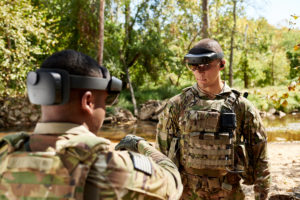The Army has officially delayed the next soldier evaluation for its future augmented reality headset from this summer to October due to the ongoing pandemic, while maintaining a goal to stick with a first unit equipped date for late fiscal year 2021.
Brig. Gen. David Hodne, director of the Soldier Lethality Cross Functional Team, said the Army’s non-traditional partnership with Microsoft [MSFT], which is producing the Integrated Visual Augmentation System, will allow the program to stick with original fielding plans despite schedule changes.

“It’s precisely because we take a nimble approach to our processes that we can shift Soldier Touch Point (STP) Three and still deliver all the same capabilities in the fall without impacting STP4 and the date we will equip that first unit. The team has always managed development across all the capability sets to capitalize on opportunities to accelerate technology or bring capabilities forward to get Soldier feedback early on,” Hodne said in a statement.
The latest IVAS update arrives after senior Army leaders told lawmakers recently that initial IVAS fielding could be pushed from FY ‘21 to FY ‘22 due to temporary closures of Microsoft’s engineering and production facilities during the pandemic (Defense Daily, April 16).
Hodne said the agility built into the Army’s partnership with Microsoft has allowed IVAS development on hardware, software and integration to continue while teleworking orders are in place.
“We can work software remotely, we can test it remotely, and we can come together using collaborative tools for design reviews. What we cannot do is get together at a location where we can’t maintain a responsible separation. Those are the things that we’re having to work our way around today to figure out what can we substitute in place and figure out how to mitigate the impacts to the schedule when those touch points are delayed,” Hodne said. “Teleworking and remote distributed operations from coast to coast were fairly unique to this program and unique to this partnership before the pandemic made them commonplace, at least for the time being, in the national workforce. We’ve been operating in this mode for the last few years, and in so many ways it has been the key to our success.”
Army officials have said previously the third IVAS soldier touchpoint scheduled for this July would be used to inform a low-rate production decision, before holding a final evaluation in spring 2021 ahead of full-rate production decision (Defense Daily, Dec. 4).
Hodne noted the third soldier touchpoint, now scheduled for this fall, will be the first test with the ruggedized version of IVAS and that the final soldier touchpoint will take place in early 2021 “to the test at the company level in a variety of combat scenarios to challenge system performance and network integration across multiple echelons.”